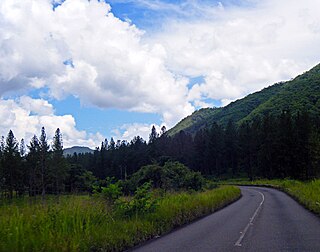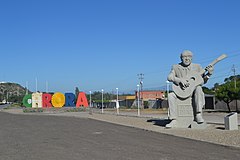Transport in Venezuela revolves around a system of highways and airports. Venezuela is connected to the world primarily via air and sea. In the south and east the Amazon rainforest region has limited cross-border transport; in the west, there is a mountainous border of over 1,375 miles (2,213 km) shared with Colombia. The Orinoco River is navigable by oceangoing vessels up to 400 km inland, and connects the major industrial city of Ciudad Guayana to the Atlantic Ocean.

Aragua State is one of the 23 states of Venezuela. It is located in the north-central region of Venezuela. It has plains and jungles and Caribbean beaches. The most popular are Cata and Choroni. It has Venezuela's first national park which is called Henri Pittier. The capital is Maracay, other important cities include Turmero and El Limón.

Lara State is one of the 23 states of Venezuela. Lara is located in the Central-Western Region, Venezuela. The state capital is Barquisimeto.

Monagas State is one of the 23 states of Venezuela.
Juan Oropeza Riera was a Venezuelan lawyer, diplomat, writer, educator and political scientist. He was born in Carora in the state of Lara, and was the younger brother of pediatrics pioneer, Pastor Oropeza Riera.

Calabozo, officially Villa de Todos los Santos de Calabozo, is a city in Venezuela located in Guárico state, capital of the Francisco de Miranda Municipality and former capital of the state. It has a population of 168,605, according to the National Institute of Statistics (INE) in 2020. It is located in the center-west of Guárico state, and is one of the main rice producers in the country. In addition, it has the largest irrigation system in Venezuela.

Municipalities of Venezuela are subdivisions of the States of Venezuela. There are 335 municipalities dividing the 23 states and the Capital District.

The Girardot Municipality is one of the 18 municipalities (municipios) that makes up the Venezuelan state of Aragua. According to the 2011 census by the National Institute of Statistics of Venezuela, the municipality has a population of 407,109. The city of Maracay is the shire town of the Girardot Municipality.

The Central University of Venezuela is a public university located in Caracas, Venezuela. Founded in 1721, it is the oldest university in Venezuela and one of the oldest in the Western Hemisphere.

The National Pantheon of Venezuela is a final resting place for national heroes. The Pantheon was created in the 1870s on the site of the ruined Santísima Trinidad church from 1744 on the northern edge of the old town of Caracas, Venezuela.

Mario Briceño Iragorry, was a Venezuelan intellectual and cultural analyst. He was also a notable writer, politician, journalist, lawyer, historian, diplomatic and teacher. He won the National Prize for Literature in 1948. The Mario Briceño Iragorry Municipality in Aragua is named for him.
Freemasonry has been present in Venezuela since 1824 and has included a number of prominent politicians.

The Roman Catholic Metropolitan Archdiocese of Caracas is an ecclesiastical territory of the Roman Catholic Church in Venezuela. It was founded as the Diocese of Caracas on June 20, 1637, and was later elevated to the rank of a metropolitan see on November 27, 1803.

The Torres Municipality is one of the eight municipalities (municipios) that makes up the Venezuelan state of Lara and, according to a 2011 population estimate by the National Institute of Statistics of Venezuela, the municipality has a population of 185.275. The town of Carora is the shire town of the Torres Municipality.
The National Prize for Literature is a literary award made annually to Venezuelan writers.
Román Delgado Chalbaud was a Venezuelan naval officer, founder, admiral, and commander in chief of the Venezuelan navy, businessman and politician. Hero of the battle of "Ciudad Bolívar", which sealed the pacification of Venezuela in 1903. Later, as head of a failed conspiracy against Juan Vicente Gómez he was imprisoned for 14 years in 1913, before attempting a naval invasion in 1929 to overthrow Gómez's regime and his Presidential front man.

The Palacio de las Academias is a Neo-Gothic building on the Avenida Universidad in the centre of Caracas, Venezuela. It dates back to 1684 when a Franciscan convent was built on the site but in the 19th century it served as a barracks, a hospital and a college. In 1876, under President Antonio Guzmán Blanco, the Universidad de Caracas was moved to the building, whose former colonial façade was rebuilt in the Neo-Gothic style. After the university relocated to a new campus in 1952, the building became home to the National Academies. In 1965, it was listed as a national monument. The Palacio de las Academias now houses six National Academies, which are the National Academy of History, the Venezuelan Academy of Language, the Academy of Medicine, the Academy of Political and Social Sciences, the Academy of Jurisprudence, and the Academy of Physics, Mathematics and Nature.
This is the list of members elected in the 2017 Constituent National Assembly of Venezuela following the 30 July 2017 elections. The first session of the assembly began on 4 August 2017 in the Oval Room of the Palacio Federal Legislativo. The Democratic Unity Roundtable—the opposition to the incumbent ruling party—also boycotted the election claiming that the Constituent Assembly was "a trick to keep [the incumbent ruling party] in power." Since the opposition did not participate in the election, the incumbent Great Patriotic Pole, dominated by the United Socialist Party of Venezuela, won almost all seats in the assembly by default.
















